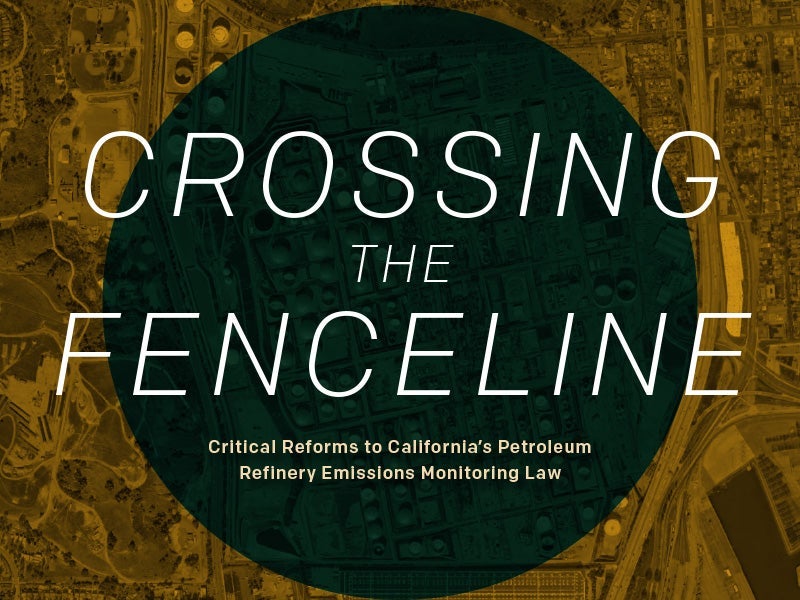Critical Reforms to California’s Petroleum Refinery Emissions Monitoring Law
Petroleum refineries are inherently dangerous operations and significant sources of pollution that put nearby community members at risk.

Petroleum refineries are inherently dangerous operations and significant sources of pollution that put nearby community members at risk. California, in particular, is home to numerous refineries that are some of the largest stationary emitters of toxic air contaminants, criteria pollutants, and greenhouse gases in the entire state.
Incidents at these refineries — including explosions, fires, and flaring events — threaten nearby community members, first responders, and refinery workers.
There is a clear need to transition away from these harmful operations but in the meantime, it is imperative that emissions are mitigated and that additional safeguards are enacted to protect public health and safety from these aging, dangerous facilities.
To this end, and in recognition of the importance of providing real-time emissions data to community members, first responders, and regulators, California legislators passed and Governor Brown signed Assembly Bill 1647, a bill to impose fenceline monitoring requirements at refineries in the state.
What are health impacts of emissions from refineries? Chemicals released by refineries have numerous adverse impacts on human health, including asthma, nausea, headaches, and liver, kidney, and heart damage, among many others
The purpose of this legislation was to understand pollution sources at refineries and ways to mitigate their hazardous emissions, and to inform and notify community members of these emissions.
Five years since Assembly Bill 1647 was enacted, it is clear that there are serious flaws in the implementation of the statute’s requirements. Specifically, these flaws include:
- Inconsistent implementation of the statutory requirements;
- Inadequate notification to the public of excess emissions;
- Lack of access to key data and information;
- Absence of corrective action to address elevated emissions;
- Inclusion of unlawful exemptions; and
- Lack of adequate fenceline monitoring coverage at some refineries.
These flaws undermine the purpose of the legislation and result in a weak and ineffective fenceline monitoring program.
The report — “Crossing the Fenceline,” presented by Earthjustice’s Community Partnerships Program — discusses the flaws in implementation of California’s fenceline monitoring program and provides recommendations to fix these problems and strengthen the program so that it better serves community members.
Summary of Problems & Recommendations
Problem
The Air Districts are inconsistently implementing Assembly Bill 1647, creating large variations in what was meant to be a uniform state-wide program.
Recommendation
The air districts, in accordance with standardized guidance developed by CARB, must:
- Ensure that refineries are measuring all necessary pollutants;
- Set threshold levels that align with OEHHA’s Reference Exposure Levels;
- Require notification of exceedances;
- Require refineries to submit and publish quarterly data reports;
- Standardize siting criteria for fenceline monitors; and
- Set technology requirements.
The air districts must update their regulations to clarify that the requirements are applicable to biorefineries.
Problem
Petroleum refineries are failing to notify the public of detected exceedances.
Recommendation
The air districts must require refineries to provide adequate public notification when thresholds are exceeded.
Problem
The underlying fenceline monitoring data and key documents are not easily accessible, which prevents community members and researchers from being able to meaningfully analyze the data.
Also, the air districts are not taking enough of an active role in analyzing the data to inform regulatory actions.
Recommendation
Refineries and the air districts must ensure that quarterly reports and data from the fenceline monitors are readily accessible for community members and researchers (see Appendix B).
The air districts must engage in a regular review and audit of the data to assess trends and variations that can inform emissions reductions and other actions.
Problem
Petroleum refineries are not required to locate and mitigate sources of toxic releases that exceed health and safety thresholds.
Recommendation
The air districts must require refineries to conduct a root cause analysis of threshold exceedances and engage in corrective action.
Problem
The air districts are unlawfully adding exemptions to their rules resulting in reduced protections for community members.
Recommendation
The air districts must remove all exemptions currently in place to comply with the intent of the statute.
Problem
Petroleum refineries are excluding portions of their facilities from fenceline monitoring, such as storage tanks, and are failing to take into consideration all of the necessary criteria to determine proper monitor siting.
Recommendation
The air districts must require refineries to include storage tank farms within their fenceline monitoring systems and must ensure that fenceline monitors are properly sited to provide adequate coverage.
CARB must standardize siting criteria to ensure that refineries are considering all relevant factors.
The Report
Health and Community Impacts of Refineries
- Relevant California Regulatory Agencies
- Implementation of Assembly Bill 1647 by the Air Districts
- Inconsistent Implementation by Air Districts
- Inadequate Public Notification of Excess Emissions
- Lack of Access to Data and Information
- Lack of Requirement to Engage in Root Cause Analysis & Corrective Action
- Inclusion of Unnecessary and Unlawful Exemptions
- Lack of Adequate Fenceline Monitoring Coverage
Summary of Problems & Recommendations
Appendix A: Incidents at Refineries (Jan. 2021 – Jun. 2022)
Appendix B: Data Access Recommendations
Acknowledgements: This report was written by Lisa Fuhrmann, Earthjustice, with input and assistance from Byron Chan, Oscar Espino-Padron, Erica Martinez, and Lupe Ruelas, Earthjustice. Feedback was provided by Gwen Ottinger, Drexel University; Jasmin Martinez and Cynthia Pinto-Cabrera, Central Valley Air Quality Coalition (CVAQ); Whitney Amaya and Jan Victor Andasan, East Yard Communities for Environmental Justice (EYCEJ); Jesus Alonso, Clean Water Action; and Gustavo Aguirre Jr., Central California Environmental Justice Network.
Media Inquiries
Community Partnerships Program
cpp@earthjustice.org
Earthjustice’s Community Partnerships Program provides legal and advocacy resources to local leaders demanding a safe, just, and healthy environment in which their communities can thrive — no matter how long the fight. Learn more.